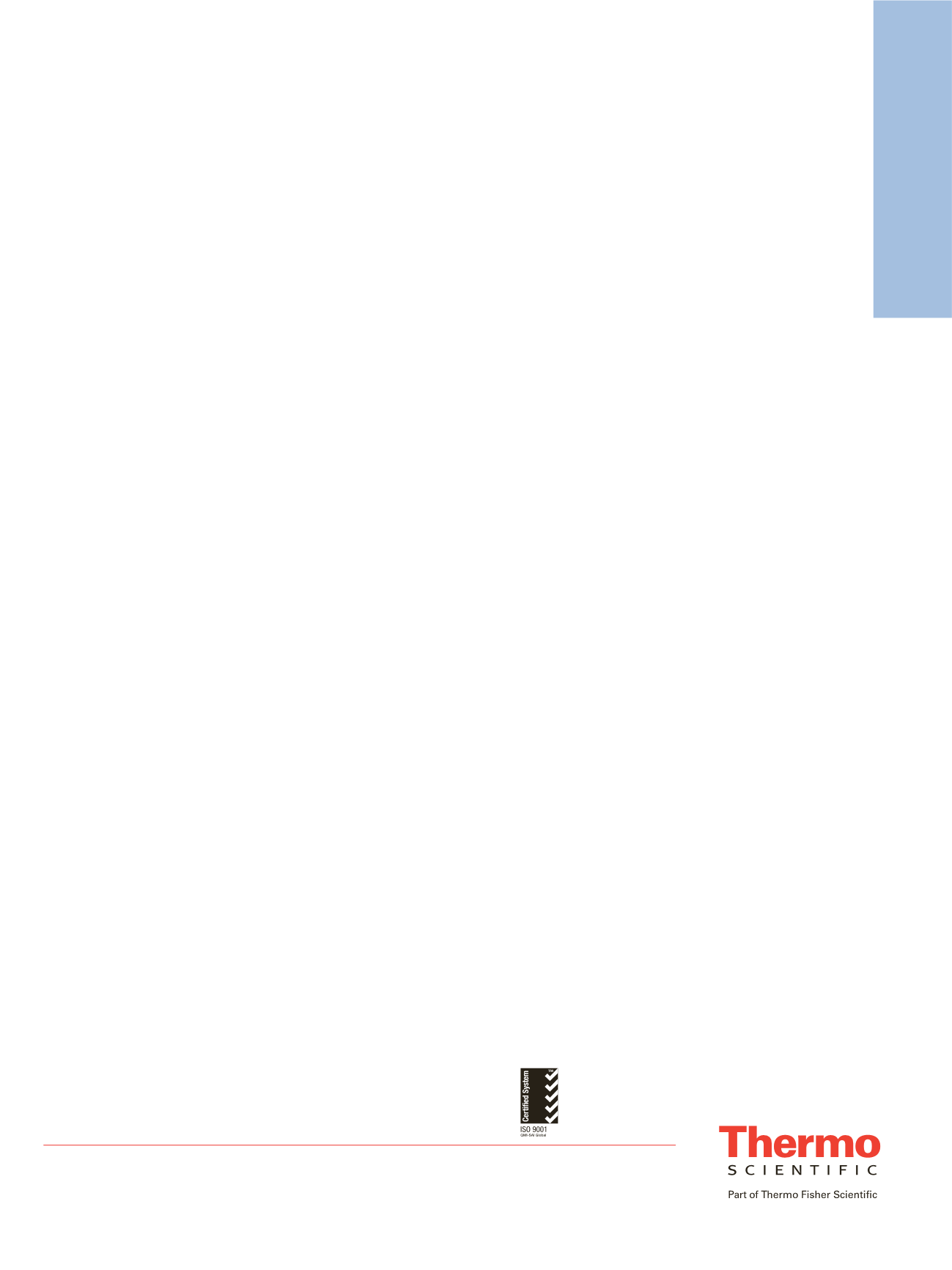

AN63678_E 04/13S
Africa-Other
+27 11 570 1840
Australia
+61 3 9757 4300
Austria
+43 1 333 50 34 0
Belgium
+32 53 73 42 41
Canada
+1 800 530 8447
China
+86 10 8419 3588
Denmark
+45 70 23 62 60
Europe-Other
+43 1 333 50 34 0
Finland/Norway/Sweden
+46 8 556 468 00
France
+33 1 60 92 48 00
Germany
+49 6103 408 1014
India
+91 22 6742 9434
Italy
+39 02 950 591
Japan
+81 45 453 9100
Latin America
+1 561 688 8700
Middle East
+43 1 333 50 34 0
Netherlands
+31 76 579 55 55
New Zealand
+64 9 980 6700
Russia/CIS
+43 1 333 50 34 0
South Africa
+27 11 570 1840
Spain
+34 914 845 965
Switzerland
+41 61 716 77 00
UK
+44 1442 233555
USA
+1 800 532 4752
www.thermoscientific.com©2013 Thermo Fisher Scientific Inc. All rights reserved. Corexit is a registered trademark of Nalco Company. PAL is a trademark of
CTC Analytics AG. Instant Ocean is a registered trademark of Spectrum Brands. ISO is a registered trademark of the International
Organization for Standardization (Organisation Internationale De Normalization). All other trademarks are the property of Thermo
Fisher Scientific Inc. and its subsidiaries. This information is presented as an example of the capabilities of Thermo Fisher Scientific
Inc. products. It is not intended to encourage use of these products in any manners that might infringe the intellectual property
rights of others. Specifications, terms and pricing are subject to change. Not all products are available in all countries. Please
consult your local sales representative for details.
Thermo Fisher Scientific,
San Jose, CA USA is
ISO 9001:2008 Certified.
Crude Oil Analysis
Calibration curves for the crude oil analysis were produced
by plotting the peak-area ratio (analyte/DDS-
2
H
25
) against
the analyte concentration in the injected solution and then
calculating the concentration in the original weight of
crude oil used. To correct for the extraction step, the average
relative response factor (RRF) of each isotopically labeled
surrogate was used.
Method detection limits for the crude oil analysis are
shown in Table 2. Excellent recoveries were obtained for
both analytes, suggesting that the single-step extraction
procedure with acetonitrile is enough to quantify both
tracers in the crude oil matrix. As expected, none of the
analytes were detected in the sweet-light crude oil from
the Wilcox formation. The oil that originated at the
MC-252 riser contained 4.0 ± 0.2 mg/kg of DOSS.
However, 2-butoxyethanol was not detected in the
MC-252 oil sample.
Conclusion
The method provides a simple yet robust tool for the
quantification of two key indicator components of
commercial Corexit formulations in seawater and crude
oil. It could be used to monitor the fate and transport of
dispersant in the months following an unintended oil
release. This direct-injection LC-MS/MS method with
simultaneous detection of both tracer compounds in two
different matrices could be quickly adopted by many
laboratories with LC-MS/MS capabilities.
References
1. U.S. Environmental Protection Agency, Emergency
Management. National Contingency Plan Product
Schedule.
http://www.epa.gov/emergencies/content/ncp/product_schedule.htm (Accessed on 11/12/2012.)
2. U.S. Government. 2010. Official federal portal for the
Deepwater BP oil spill response and recovery.
Operations and Ongoing Response August 28, 2010.
http://www.restorethegulf.gov/release/2010/08/28/
operations-and-ongoing-response-august-28-2010.
(Accessed on 10/12/2010.)
3. NALCO. 2012. NALCO safety data sheet product
Corexit
®
EC9500A.
http://www.nalcoesllc.com/nes/documents/MSDS/NESLLC- COREXIT-EC9500A-
March_2012.pdf. (Accessed 02/05/2013)
4. Chapman, H.; Purnel,l K.; Law, R.J.; Kirby,
Marine
Pollution Bulletin
2007
,
54
, 827-838. doi:10.1016/j.
marpolbul.2007.03.012
5. NALCO. 2012. NALCO safety data sheet product
Corexit
®
EC9527A.
http://www.nalcoesllc.com/nes/documents/MSDS/NESLLC-COREXIT-_EC9527A-
March_2012.pdf. (Accessed on 02/05/2013.)
6. Georges-Ares, A.; Clark, J.R. Aquatic toxicity of
two Corexit
®
dispersants.
Chemosphere
2000
, 40
,
897-906.
7. Harris, O.; Wilbur, S.; George, J.; Eisenmann, C.
1998
.
Toxicological Profile for 2-butoxyethanol and
2-butoxyethanol acetate. U.S. Department of Health
and Human Services, Agency for Toxic Substances and
Disease Registry, Atlanta, GA. USA., 296.
8. U.S. Environmental Protection Agency, 2010, U.S.
Code of Federal Regulations, Title 40. Part 136,
Appendix B: Definition and procedures for the
determination of the method detection limit-Revision
1.11. Office of the Federal Register, Washington, DC.
USA.
9. U.S. Environmental Protection Agency, 2010,
Emergency Management. Methods for Detecting
Dispersants in Water. 11/12/2012.
(http://www.epa.gov/bpspill/dispersant-methods.html).
Application Note 586



















